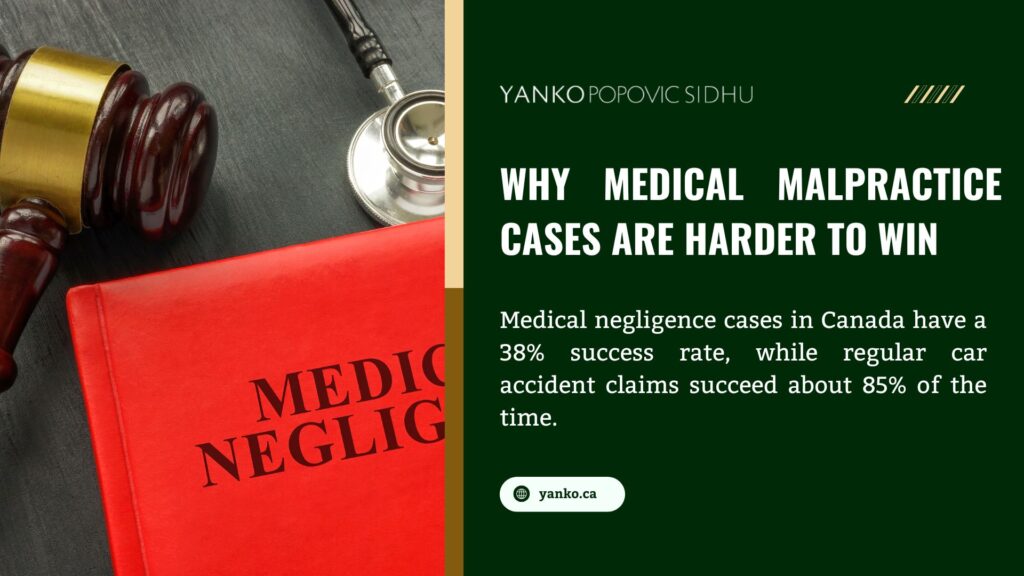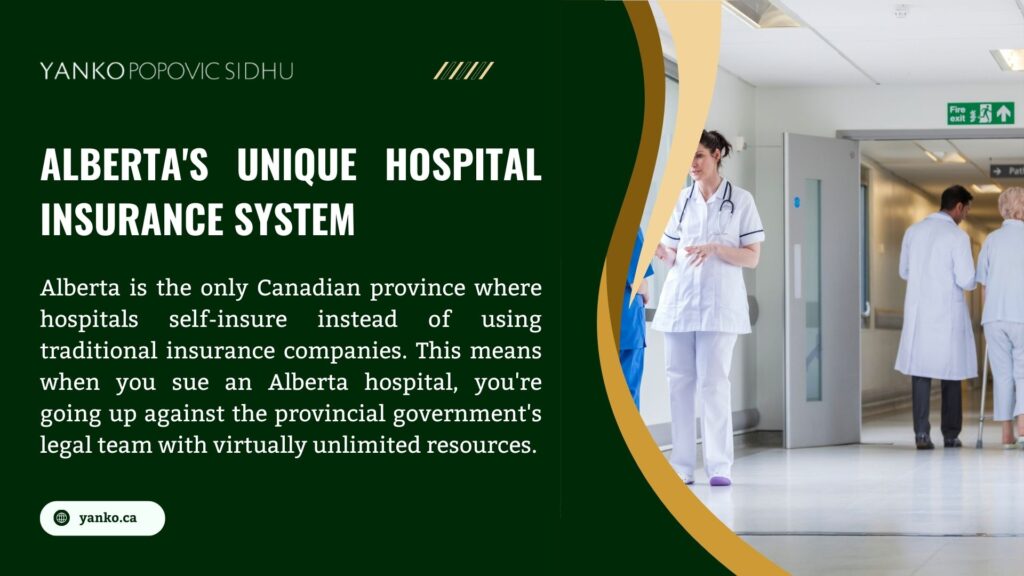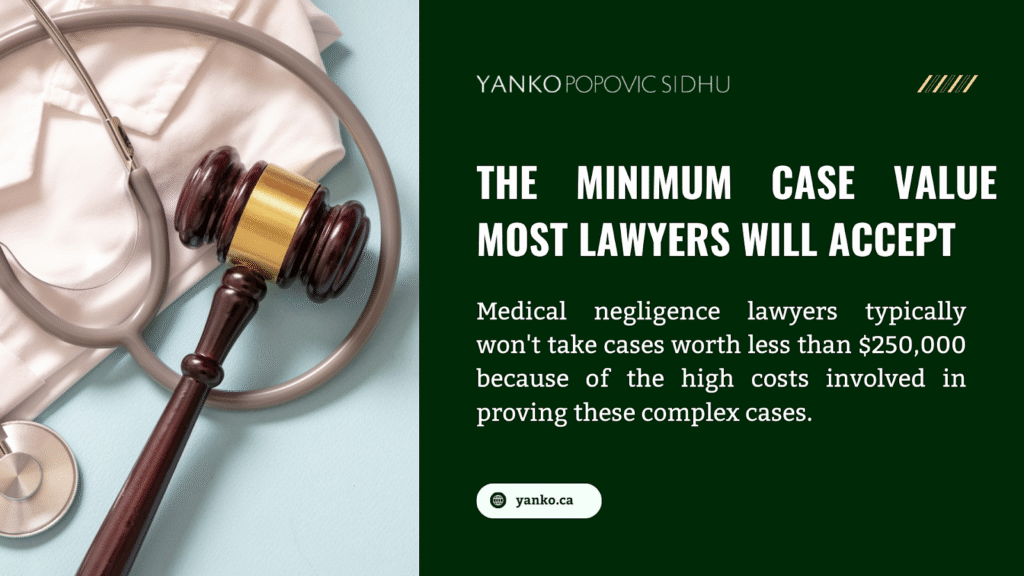Did you know that only 0.34% of medical errors in Canada result in successful compensation for patients? Yet many victims of medical negligence still struggle to get fair compensation because they don’t know how the system works.
From decades of practice in Calgary, we as experienced personal injury lawyers have seen countless clients who could have received much better medical negligence compensation if they had known what to expect. The medical malpractice claims process in Alberta has specific rules and timelines that can make or break your case.
When you’re dealing with medical bills, ongoing treatment, and pain from medical errors, the last thing you want is to leave money on the table because of a simple mistake.
In this article, you will have a complete guide to medical negligence compensation and how it works in Alberta.

What Does Medical Negligence Compensation Do?
Medical negligence compensation gives you money when healthcare professionals fail to meet the standard of care expected in their field. These claims cover your medical costs, lost paychecks, pain and suffering, and other damages from medical errors.
Alberta uses the same legal framework as other Canadian provinces for medical malpractice claims. You must prove that the healthcare provider’s actions fell below accepted professional standards and that this negligence directly caused your injuries.
The law lets you ask for money for things you can count (like medical bills) and things you can’t count (like pain). But you have to act fast. Most claims must be filed within two years of discovering the negligence.
Unlike car accidents where you get immediate no-fault benefits, medical negligence cases rely entirely on proving fault through the court system.
Types of Medical Negligence Cases in Alberta
Alberta courts handle many different types of medical negligence cases. Each type has its own challenges and typical compensation ranges.
| Type of Medical Error | Common Examples | Typical Compensation Range* |
| Surgical Errors | Wrong procedures, retained objects, post-op complications | $250,000 – $3,000,000+ |
| Misdiagnosis / Delayed Diagnosis | Missed cancer, stroke, infections | $200,000 – $5,000,000+ |
| Birth Injuries | Oxygen deprivation, cerebral palsy, delivery trauma | $500,000 – $8,000,000+ |
| Medication Errors | Wrong drug, incorrect dosage, allergic reaction | $100,000 – $2,000,000+ |
| Nursing Home Neglect | Falls, malnutrition, untreated infections | $100,000 – $750,000+ |
Surgical error cases often involve clear evidence of what went wrong. Objects left inside patients, wrong procedures, or operations on the wrong body parts create strong cases with substantial compensation potential.
Misdiagnosis cases make up a large portion of medical negligence claims. Cancer misdiagnosis cases often result in the highest settlements because delayed treatment can be fatal or require more extensive intervention.
Birth injury cases typically result in the largest awards because children have decades of life ahead requiring specialized care. These cases often involve complex medical evidence about what should have happened during delivery.
The most successful suing hospital for negligence in canada cases involve clear documentation of the error and strong expert medical testimony about how the standard of care was breached.
Common Settlement Factors in Alberta
Several things determine how much money you’ll get from your medical negligence compensation claim. Courts and insurance companies look at all these factors when they decide what to pay you.
Factor | Impact on Settlement | What Courts Consider |
Injury Severity | Very high impact | Permanent vs temporary damage |
Age of Victim | High impact | Years of lost earning potential |
Income Level | High impact | Current and future earning capacity |
Medical Costs | Moderate to high | Treatment needs and duration |
Standard of Care Breach | Critical | How far below standard the care fell |
Recovery Prospects | Moderate impact | Return to normal activities |
How Bad Your Injuries Are: Worse injuries mean more money. If you’re left with permanent disability, brain damage, or chronic pain, you’ll get much more than someone who recovers completely within months.
Your Medical Bills: Alberta’s health system covers basic treatment. But many injury-related costs aren’t covered. Private rehabilitation, specialized equipment, and ongoing therapy can add up to hundreds of thousands of dollars.
Lost Income: If you can’t work because of the medical error, you get paid for that lost time. If you’ll never be able to do your old job again, you get money for future lost earnings too.
Younger people usually get more money. They have more years of work ahead of them. A 25-year-old who can’t work gets significantly more than a 60-year-old with the same injury.
How Clear the Negligence Is: Cases with obvious errors get better settlements. A surgical instrument left inside someone is easier to prove than a judgment call about treatment timing.

Alberta’s Medical Liability System
Alberta’s medical liability system differs from other provinces in several important ways. Alberta Health Services operates its own self-insurance program rather than using traditional insurance companies.
Insurance Type | Coverage Provider | Impact on Claims |
Physician Coverage | Canadian Medical Protective Association | Strong defense resources |
Hospital Coverage | Alberta Health Services Self-Insurance | Government-backed defense |
Other Professionals | Various private insurers | Mixed defense capabilities |
How the CMPA Works: The Canadian Medical Protective Association isn’t really an insurance company. It’s a defense fund paid for by doctors to protect doctors. They have over $5 billion in resources to fight claims against physicians.
Alberta Health Services: Hospitals and their employees get defended by the provincial government through their self-insurance program. This means you’re often fighting against government lawyers with unlimited resources.
What This Means for You: Both systems have massive resources to fight your claim. They employ teams of lawyers, medical experts, and investigators. This is why experienced legal representation becomes critical for medical negligence compensation cases.
The defense typically tries to argue that the outcome would have happened anyway, that the care met acceptable standards, or that other factors caused the injury.
How the Claims Process Works
Medical negligence claims follow a complex process that can take years. Each step has deadlines and requirements you need to meet to protect your right to compensation.
Process Step | Timeline | Key Actions |
| Medical Treatment | Immediate | Document all treatment and complications |
| Evidence Collection | First 60 days | Medical records, expert consultations |
| Legal Consultation | Within 6 months | Case assessment and strategy |
| Formal Claim | Within 2 years | File statement of claim |
| Discovery Process | 6-18 months | Document exchange and examinations |
| Settlement Negotiations | 12-36 months | Offers and counteroffers |
| Trial Preparation | If needed | Expert witnesses and final preparation |
Get Medical Treatment First: Your health comes before any legal case. Follow all medical advice and attend every appointment. Gaps in treatment hurt your claim by making it look like you weren’t really injured.
Collect All Evidence: Keep copies of all medical records, test results, and correspondence with healthcare providers. Take photos of visible injuries. Write down everything you remember about what happened.
Medical Records Are Key: Request complete medical files from all providers involved in your care. These records become the foundation of your case. Missing or altered records can destroy claims.
Expert Medical Opinion: You’ll need qualified doctors to review your case and provide opinions about whether the care met professional standards. Finding the right experts often determines case success.
Most medical negligence cases get settled through negotiations rather than going to trial. But having a lawyer prepared for trial often results in better settlement offers.
For more detailed guidance on medical malpractice claims, contact our experienced medical malpractice team who can walk you through every step of the process.
How to Calculate Medical Negligence Compensation
Smart calculation methods help you understand what your case might be worth. These approaches require detailed analysis and professional expertise.
Damage Type | Calculation Method | Typical Range |
| Medical Expenses | Actual receipts plus future costs | $10,000 – $500,000+ |
| Lost Wages | Income records x time off work | $5,000 – $200,000+ |
| Future Earnings | Career potential x disability impact | $100,000 – $2,000,000+ |
| Pain and Suffering | Case precedents and injury severity | $25,000 – $401,709 |
Special Damages (also called pecuniary damages): These are losses you can prove with receipts and financial records. They include past and future medical expenses, lost wages, and care costs.
General Damages (also called non pecuniary damages): These cover pain, suffering, and loss of life enjoyment. Canada caps these damages at about $401,709, adjusted annually for inflation.
Future Care Costs: Often the largest part of serious injury settlements. This includes ongoing medical treatment, rehabilitation, equipment, and personal care assistance for life.
Loss of Earning Capacity: If your ability to work gets reduced, you receive compensation for that lost potential. Younger victims with higher incomes typically get larger awards.
Calculations require economic experts who analyze your specific situation. They consider your career prospects, inflation rates, and life expectancy to determine fair compensation amounts.
When You Need a Lawyer for Medical Negligence
Some situations absolutely require professional legal help. Medical negligence cases are more complex than other personal injury claims and success rates are lower without experienced representation.
| Situation | Need for Lawyer | Why It Matters |
| Minor Complications | Moderate | Still need case assessment |
| Permanent Disability | Critical | Complex future damage calculations |
| Death Cases | Critical | Specialized wrongful death procedures |
| Surgical Errors | High | Technical medical evidence required |
| Multiple Providers | Critical | Complex liability coordination |
If You Have Permanent Disability: Chronic pain, brain injuries, or permanent physical limitations require specialized legal knowledge. These cases involve complex medical evidence and calculations for lifetime care costs.
If Someone Died: Wrongful death cases have different rules and procedures. Family members can claim dependency losses and other specific damages not available in regular injury cases.
If Multiple Healthcare Providers Were Involved: Cases involving hospitals, multiple doctors, and other staff require careful analysis of each person’s role. Liability often gets shared among several parties.
If the Negligence Is Disputed: Healthcare providers rarely admit fault. You’ll need expert medical testimony to prove that care fell below acceptable standards and caused your injuries.
The Canadian Medical Protective Association fights these cases aggressively. They have unlimited resources and experienced lawyers. Going against them without proper representation usually results in failed claims.

Typical Settlement Amounts by Injury Type
Alberta courts follow Canadian precedents for medical negligence compensation amounts. But every case is different based on your specific circumstances and the strength of your evidence.
Injury Type | Typical Range | What Affects the Amount |
| Minor Complications | $10,000 – $50,000 | Recovery time and ongoing symptoms |
| Surgical Infections | $25,000 – $150,000 | Treatment duration and complications |
| Misdiagnosis Cases | $75,000 – $1,000,000+ | Stage of disease when caught |
| Birth Injuries | $500,000 – $8,000,000+ | Severity of brain damage or disability |
| Wrongful Death | $200,000 – $2,000,000+ | Age and earning capacity of deceased |
These ranges show general trends in Canadian settlements and jury awards. Your case might be higher or lower depending on your specific circumstances and the quality of evidence available.
Recent data shows medical negligence settlements have increased moderately over the past five years. This reflects higher medical costs and changing attitudes about pain and suffering awards.
The highest medical malpractice award in Canadian history reached approximately $15 million. But such large awards are extremely rare and typically involve catastrophic birth injuries with lifetime care requirements.
For examples of actual personal injury settlement amounts examples, review court decisions and settlement reports that provide insight into compensation calculations.
Medical Negligence Laws and Time Limits
Alberta’s medical negligence laws follow federal guidelines while incorporating provincial procedures. These laws set strict deadlines that can destroy your case if missed.
| Legal Requirement | Time Limit | Impact on Claims |
Discovery of Negligence | 2 years to file | Case dismissed if deadline missed |
Medical Record Requests | No specific limit | Earlier requests get better records |
Expert Medical Opinions | Case dependent | Required for all negligence claims |
Limitation Periods: Alberta’s law requires most medical negligence claims to be filed within two years of discovering the error. This doesn’t mean two years from when it happened – it means two years from when you knew or should have known about the negligence.
Discovery Rule: Sometimes medical errors aren’t obvious right away. The limitation period starts when a reasonable person would have known that medical negligence caused their injury. This can be years after the original treatment.
Medical Record Access: Healthcare providers must give you copies of your complete medical files. But getting records becomes harder over time as files get archived or destroyed. Request records immediately if you suspect negligence.
Expert Medical Requirements: Alberta courts require expert medical testimony to prove negligence cases. These experts must be qualified in the same specialty as the defendant and practice in similar circumstances.
Missing limitation deadlines usually means you lose your right to compensation permanently. Very few exceptions exist, and they’re difficult to prove in court.
Four Common Mistakes That Destroy Your Case
Avoid these mistakes that can reduce your medical negligence compensation or eliminate your case completely.
| Mistake | Consequence | How to Avoid |
Delayed Legal Consultation | Missed evidence and deadlines | Consult lawyer within months |
Incomplete Medical Records | Weak evidence foundation | Request all records immediately |
Social Media Posts | Evidence used against you | Avoid posting about health |
Quick Settlement | Can’t change mind later | Wait for full injury assessment |
Waiting Too Long to Get Legal Help: Medical negligence cases require immediate action to preserve evidence and meet deadlines. Healthcare facilities often change computer systems, staff moves on, and memories fade.
Not Getting Complete Medical Records: Partial records won’t prove your case. You need everything – nursing notes, test results, consultation reports, and treatment plans. Missing records often contain the key evidence.
Continuing Treatment with the Same Provider: This can hurt your case by making it look like you still trust the provider who allegedly harmed you. Get second opinions and alternative treatment when possible.
Talking to Insurance Representatives: Healthcare facility insurance adjusters will try to get statements from you. These conversations get recorded and used against you later. Only communicate through your lawyer.
Social Media Activity: Insurance companies monitor social media for evidence. Photos showing you active or happy can be used to argue your injuries aren’t serious. Avoid posting about your health or activities.
Once you sign a settlement agreement, you can’t change your mind later. If your injuries turn out worse than expected, you’re stuck with the amount you agreed to accept.
The Role of Expert Medical Witnesses
Medical negligence cases live or die based on expert medical testimony. These experts must prove that the care you received fell below acceptable professional standards.
Standard of Care Testimony: Experts explain what a competent healthcare provider should have done in your situation. They compare the actual care to accepted medical practices and identify specific failures.
Causation Analysis: Even if negligence occurred, you must prove it caused your injuries. Medical experts analyze whether your injuries would have happened anyway or if the negligence made them worse.
Damage Assessment: Medical experts evaluate the extent of your injuries, future treatment needs, and long-term prognosis. Their opinions directly impact compensation calculations.
Cost Considerations: Expert medical witnesses charge $500-$1,500 per hour for case review and testimony. Major cases might require multiple experts costing $50,000-$100,000 total. This is why personal injury settlement cases need careful evaluation before proceeding.
Finding qualified experts who will testify against their colleagues requires experience and professional networks that most people don’t have access to independently.

Calculation Methods for Different Damage Types
Medical negligence compensation gets calculated using established methods that courts recognize. Each type of damage has specific calculation approaches.
Special Damages Calculation: These damages have specific dollar amounts you can prove with documentation. Add up all medical bills, prescription costs, travel expenses for treatment, and lost wages. Include future medical costs and ongoing care requirements based on medical expert projections.
General Damages Assessment: Pain and suffering calculations use precedent cases with similar injuries. Courts look at how other judges awarded compensation for comparable situations. The current maximum in Canada is $401,709.
Future Earning Loss: Calculate your pre-injury earning capacity minus your post-injury capacity, multiplied by working years remaining until retirement. Account for inflation, career advancement potential, and benefit losses.
Future Care Costs: Life care planners estimate all future medical needs, rehabilitation, equipment, and personal assistance. These calculations often represent the largest component of catastrophic injury settlements.
The pecuniary vs non-pecuniary damages distinction affects how courts calculate and award compensation. Pecuniary damages have no legal caps, while non-pecuniary damages are limited to about $400,000 maximum.
Medical Negligence vs Other Personal Injury Claims
Medical negligence cases differ significantly from other types of personal injury claims in several important ways that affect compensation and success rates.
Evidence Requirements: Medical negligence requires expert testimony to prove the case. Car accident settlement cases often rely on police reports and witness testimony. Medical cases need qualified doctors willing to testify against their colleagues.
Defense Resources: The CMPA and Alberta Health Services have unlimited resources to fight medical negligence claims. Car insurance companies typically settle reasonable claims quickly to avoid trial costs.
Success Rates: Medical negligence cases succeed about 38% of the time in Canada. Other personal injury claims have success rates closer to 80-90%. The lower success rate reflects the complexity of proving medical negligence.
Time to Resolution: Medical negligence cases typically take 3-5 years to resolve. Simple car accident cases often settle within 12-18 months. The extra time reflects the need for extensive medical evidence and expert testimony.
Compensation Amounts: While maximum awards can be similar, average medical negligence settlements are often higher because they typically involve more serious injuries requiring long-term care.
The complexity and lower success rates mean medical negligence cases require more careful evaluation before proceeding compared to other injury types.
Cost Considerations for Medical Negligence Claims
Medical negligence cases cost more to pursue than other personal injury claims. These costs affect both your decision to proceed and your final compensation amount.
Expert Witness Costs: Medical experts charge $500-$1,500 per hour for case review, report preparation, and testimony. Complex cases might require 3-5 different experts costing $75,000-$150,000 total.
Medical Record Costs: Obtaining complete medical files can cost thousands of dollars. Hospitals charge for copying extensive records, and you might need records from multiple facilities.
Investigation Expenses: Thorough case investigation includes medical literature research, additional testing, and sometimes recreating medical procedures to demonstrate negligence.
Trial Preparation: If settlement negotiations fail, trial preparation costs can exceed $100,000. This includes expert witness preparation, medical demonstrative aids, and extensive lawyer time.
Contingency Fee Arrangements: Most medical negligence lawyers work on contingency, taking 30-40% of any settlement or award. This means you don’t pay unless you win, but successful cases result in significant legal fees.
Cost Protection: Alberta’s legal system can order unsuccessful plaintiffs to pay the defendant’s legal costs. These costs can reach $200,000-$500,000 in complex medical negligence trials.
Understanding these costs helps explain why many lawyers won’t take medical negligence cases worth less than $250,000. The expense of properly pursuing these claims requires substantial potential compensation to justify the risk.
Types of Medical Negligence Compensation Available
Alberta courts can award several different types of compensation depending on your specific situation and the harm you suffered.
Past Medical Expenses: Reimbursement for all medical costs related to treating the negligence-caused injuries. This includes hospital bills, specialist consultations, diagnostic tests, medications, and rehabilitation therapy.
Future Medical Care: Compensation for all anticipated future medical needs related to your injuries. This often represents the largest portion of catastrophic injury settlements and requires detailed life care planning.
Lost Income to Date: Compensation for wages and benefits lost from the time of injury until settlement or trial. This includes sick leave used, vacation time forfeited, and any unpaid time off work.
Future Income Loss: Compensation for reduced earning capacity caused by your injuries. This calculation considers your career prospects, advancement potential, and the impact of disabilities on your ability to work.
Pain and Suffering Compensation: Awards for physical pain, emotional distress, and reduced quality of life. These are capped at approximately $401,709 but most cases receive much less depending on injury severity.
Loss of Housekeeping Capacity: Compensation for your reduced ability to maintain your home and care for your family. This relatively new category of damages recognizes the economic value of domestic services.
Family Members’ Claims: In severe cases, spouses and children can claim compensation for their own losses, including care services they must now provide and loss of companionship.
The combination of these different compensation types often results in substantial total awards for serious medical negligence cases, even though individual categories might seem modest.
Real Settlement Examples and Case Studies
Alberta medical negligence settlements vary widely based on specific circumstances, but examining actual cases helps understand compensation patterns.
Birth Injury Cases: A delayed cesarean section resulting in cerebral palsy settled for $4.7 million. The child required lifetime care, special education, and medical support. The settlement covered 70 years of projected care costs.
Surgical Error Cases: A retained surgical instrument requiring multiple corrective surgeries settled for $850,000. The patient suffered ongoing pain, missed a year of work, and needed extensive rehabilitation.
Cancer Misdiagnosis Cases: A two-year delay in diagnosing breast cancer settled for $1.2 million. The delay required more aggressive treatment, reduced survival chances, and caused significant emotional trauma.
Medication Error Cases: An allergic reaction to improperly prescribed medication causing permanent kidney damage settled for $450,000. The patient required ongoing dialysis and eventual kidney transplant.
Hospital Negligence Cases: A patient falling in hospital causing spinal cord injury settled for $3.2 million. The settlement covered wheelchair accessibility modifications, lifetime care assistance, and lost earning capacity.
These examples demonstrate how non pecuniary damages examples combine with economic losses to create substantial compensation packages for serious medical errors.
Settlement amounts depend heavily on the strength of expert medical testimony and the clarity of documentation proving both negligence and causation.
Working with Healthcare Providers After Negligence
The relationship with your healthcare providers becomes complicated after medical negligence occurs. How you handle these relationships can affect your compensation claim.
Continued Treatment Considerations: You might need to continue treatment with the same healthcare system that caused your injuries. This creates challenges for your legal case because it can appear you still trust the providers.
Medical Record Requests: Healthcare providers must provide your complete medical records, but they often try to limit what they release. Formal legal requests through your lawyer typically get more complete records.
Communication Guidelines: Avoid discussing your legal case with any healthcare providers involved. They might try to get you to make statements that could hurt your claim. All communication should go through your lawyer.
Second Opinion Importance: Getting independent medical opinions serves two purposes – it provides better treatment options and creates evidence for your legal case. Choose providers with no connection to the original healthcare team.
Documentation Protocol: Continue documenting all symptoms, limitations, and treatment responses. This ongoing record helps prove the continuing impact of the original negligence on your health and daily life.
Future Treatment Planning: Work with your legal team to coordinate future medical care with case strategy. Some treatment decisions can impact the strength of your negligence claim.
The goal is getting proper medical care while protecting your legal rights. Experienced medical negligence lawyers help balance these competing interests throughout your case.
FAQs About Medical Negligence Compensation in Alberta
- How long do I have to file a medical negligence claim in Alberta?
You have two years from when you discovered or should have discovered the negligence to file your claim. This discovery rule means the clock doesn’t start ticking until you know medical error caused your injuries.
- What is the maximum compensation for pain and suffering in Alberta?
The current maximum for general damages (pain and suffering) in Alberta is approximately $401,709, adjusted annually for inflation. This cap only applies to non-economic damages, not medical expenses or lost income.
- Do I need expert medical witnesses for my case?
Yes, Alberta courts require expert medical testimony to prove negligence cases. These experts must be qualified in the same medical specialty as the healthcare provider you’re suing.
- How much do medical negligence lawyers charge in Alberta?
Most medical negligence lawyers work on contingency fees of 30-40% of any settlement or court award. You don’t pay legal fees unless your case is successful.
- What if I can’t afford the costs of pursuing my case?
Experienced medical negligence lawyers advance all case costs including expert witnesses, medical records, and court fees. These costs get repaid from any successful settlement or award.
- Can I sue if the medical error didn’t cause permanent damage?
Yes, but the potential compensation must justify the costs of pursuing the case. Most lawyers won’t take cases worth less than $250,000 because of the high expenses involved in medical negligence litigation.
- What happens if I lose my medical negligence case?
If you lose at trial, you might be ordered to pay the defendant’s legal costs. This can amount to $200,000-$500,000 in complex cases. Most lawyers evaluate this risk carefully before taking cases to trial.
Conclusion
Medical negligence compensation in Alberta can provide crucial financial support after healthcare errors. But the system has complex rules, high costs, and strict deadlines. Success depends on proper documentation, expert medical testimony, and strategic case development throughout the process.
The province’s medical liability system strongly favors healthcare providers through well-funded defense organizations. Getting fair compensation often requires experienced legal representation who can match these resources and expertise.
Most importantly, don’t try to handle serious medical negligence claims on your own. Healthcare providers have teams of lawyers and medical experts working to minimize what they pay you. You need experienced representation to level the playing field.

Yanko Popovic Sidhu has helped thousands of Alberta residents get fair compensation for their injuries over more than 40 years. Our lawyers know how to navigate Alberta’s complex medical negligence system and fight for the money you deserve.Contact us today for a free consultation about your case. We work on contingency, so you pay nothing unless we recover compensation for your medical negligence claim.







